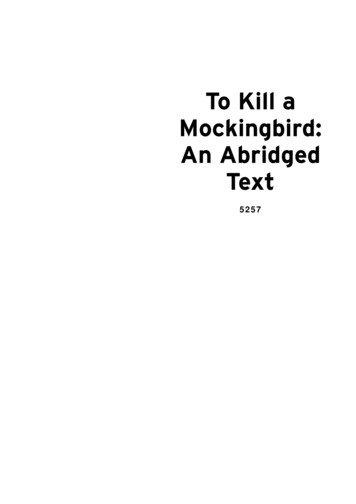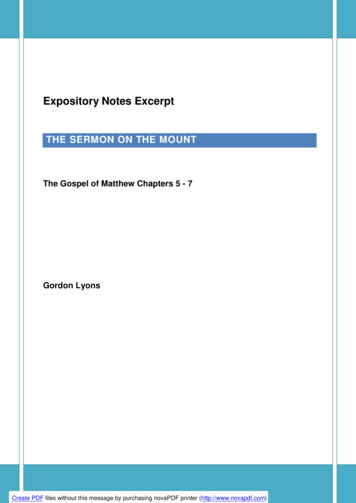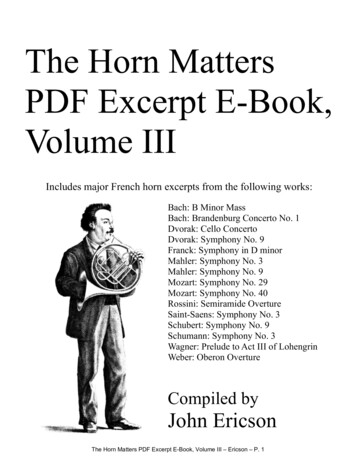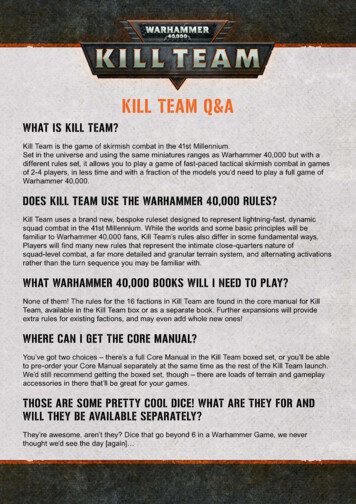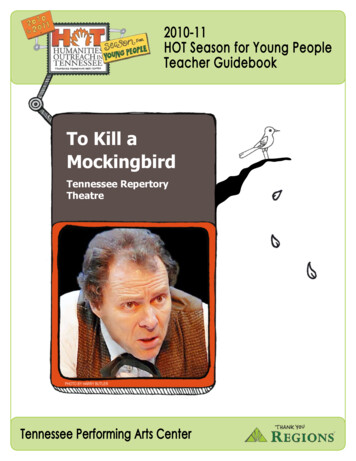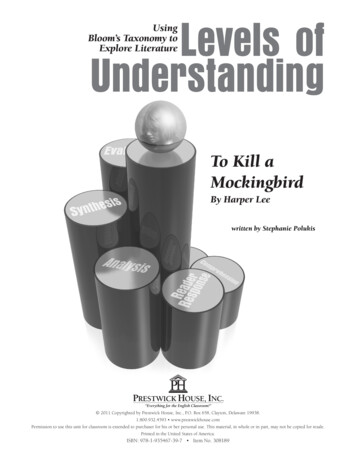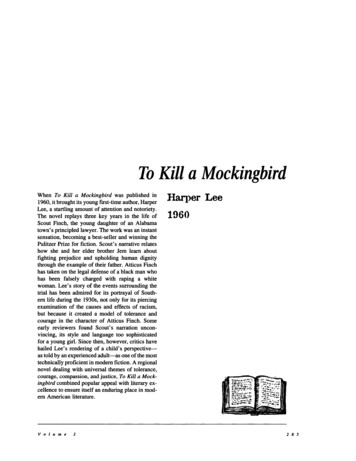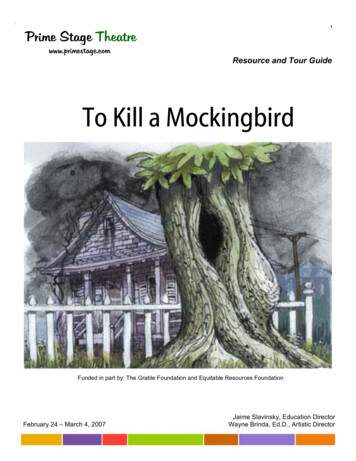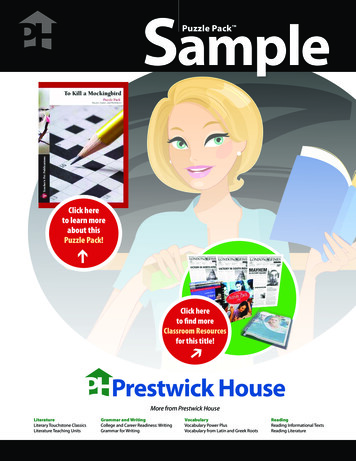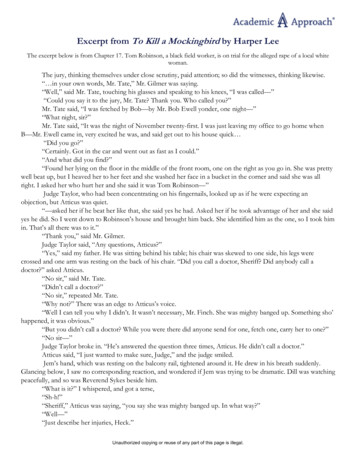
Transcription
Excerpt from To Kill a Mockingbird by Harper LeeThe excerpt below is from Chapter 17. Tom Robinson, a black field worker, is on trial for the alleged rape of a local whitewoman.The jury, thinking themselves under close scrutiny, paid attention; so did the witnesses, thinking likewise.“ in your own words, Mr. Tate,” Mr. Gilmer was saying.“Well,” said Mr. Tate, touching his glasses and speaking to his knees, “I was called—”“Could you say it to the jury, Mr. Tate? Thank you. Who called you?”Mr. Tate said, “I was fetched by Bob—by Mr. Bob Ewell yonder, one night—”“What night, sir?”Mr. Tate said, “It was the night of November twenty-first. I was just leaving my office to go home whenB—Mr. Ewell came in, very excited he was, and said get out to his house quick “Did you go?”“Certainly. Got in the car and went out as fast as I could.”“And what did you find?”“Found her lying on the floor in the middle of the front room, one on the right as you go in. She was prettywell beat up, but I heaved her to her feet and she washed her face in a bucket in the corner and said she was allright. I asked her who hurt her and she said it was Tom Robinson—”Judge Taylor, who had been concentrating on his fingernails, looked up as if he were expecting anobjection, but Atticus was quiet.“—asked her if he beat her like that, she said yes he had. Asked her if he took advantage of her and she saidyes he did. So I went down to Robinson’s house and brought him back. She identified him as the one, so I took himin. That’s all there was to it.”“Thank you,” said Mr. Gilmer.Judge Taylor said, “Any questions, Atticus?”“Yes,” said my father. He was sitting behind his table; his chair was skewed to one side, his legs werecrossed and one arm was resting on the back of his chair. “Did you call a doctor, Sheriff? Did anybody call adoctor?” asked Atticus.“No sir,” said Mr. Tate.“Didn’t call a doctor?”“No sir,” repeated Mr. Tate.“Why not?” There was an edge to Atticus’s voice.“Well I can tell you why I didn’t. It wasn’t necessary, Mr. Finch. She was mighty banged up. Something sho’happened, it was obvious.”“But you didn’t call a doctor? While you were there did anyone send for one, fetch one, carry her to one?”“No sir—”Judge Taylor broke in. “He’s answered the question three times, Atticus. He didn’t call a doctor.”Atticus said, “I just wanted to make sure, Judge,” and the judge smiled.Jem’s hand, which was resting on the balcony rail, tightened around it. He drew in his breath suddenly.Glancing below, I saw no corresponding reaction, and wondered if Jem was trying to be dramatic. Dill was watchingpeacefully, and so was Reverend Sykes beside him.“What is it?” I whispered, and got a terse,“Sh-h!”“Sheriff,” Atticus was saying, “you say she was mighty banged up. In what way?”“Well—”“Just describe her injuries, Heck.”Unauthorized copying or reuse of any part of this page is illegal.
“Well, she was beaten around the head. There was already bruises comin’ on her arms, and it happenedabout thirty minutes before—”“How do you know?”Mr. Tate grinned. “Sorry, that’s what they said. Anyway, she was pretty bruised up when I got there, and shehad a black eye comin’.”“Which eye?”Mr. Tate blinked and ran his hands through his hair.“Let’s see,” he said softly, then he looked at Atticus as if he considered the question childish.“Can’t you remember?” Atticus asked.Mr. Tate pointed to an invisible person five inches in front of him and said,“Her left.”“Wait a minute, Sheriff,” said Atticus. “Was it her left facing you or her left looking the same way youwere?”Mr. Tate said, “Oh yes, that’d make it her right. It was her right eye, Mr. Finch. I remember now, she wasbanged up on that side of her face ” Mr. Tate blinked again, as if something had suddenly been made plain to him.Then he turned his head and looked around at Tom Robinson. As if by instinct, Tom Robinson raised his head.Something had been made plain to Atticus also, and it brought him to his feet.“Sheriff, please repeat what you said.”“It was her right eye, I said.”“No ” Atticus walked to the court reporter’s desk and bent down to the furiously scribbling hand. Itstopped, flipped back the shorthand pad, and the court reporter said,“‘Mr. Finch. I remember now she was banged up on that side of the face.’” Atticus looked up at Mr. Tate.“Which side again, Heck?”“The right side, Mr. Finch.”Unauthorized copying or reuse of any part of this page is illegal.
1) In one sentence, summarize what is happening in the passage.2) Share your sentence with a neighbor. Are your summaries similar or different? What are some of the strengthsand weaknesses of each of your summaries? Based on your conversation, revise your summary to make it evenbetter.3) Why do you think the author included the following exchange? What was she trying to communicate?“Anyway, she was pretty bruised up when I got there, and she had a black eye comin’.” “Which eye?” Mr. Tateblinked and ran his hands through his hair. “Let’s see,” he said softly, then he looked at Atticus as if heconsidered the question childish. “Can’t you remember?” Atticus asked. Mr. Tate pointed to an invisible personfive inches in front of him and said, “Her left.” “Wait a minute, Sheriff,” said Atticus. “Was it her left facing youor her left looking the same way you were?” Mr. Tate said, “Oh yes, that’d make it her right. It was her right eye,Mr. Finch. I remember now ”4) Do you think that the information in the passage suggests that Tom Robinson is guilty or not guilty? Provideone piece of text-based evidence for your answer.Unauthorized copying or reuse of any part of this page is illegal.
Scottsboro Boys: Clarence Norris’ Statement, 1976The information in this passage is about a historical event and contains a first-hand account from one of the individualsinvolved. In 1931, nine black teenagers, called the Scottsboro Boys, were accused of attacking two white women on a train.One of the accused, Clarence Norris, was wrongly convicted in 1937. On October 25, 1976, Clarence Norris was pardoned.The passage below is his account of his experience. Harper Lee is said to have drawn on the real-life experiences of theScottsboro Boys in writing To Kill a Mockingbird.“I never thought I’d see the day that I would go back to Alabama for any reason whatsoever. And as far as Iwas concerned I could have skipped that, and they could have mailed the pardon to me. But plans were made forthe pardons and paroles board to give me the pardon personally in the Capitol building in Montgomery. OnNovember 29, 1976, I returned to Alabama a free man, nearly forty-six years after being taken off that freight train.There were a few hundred people waiting at the airport, and to be frank I was scared to get off the plane. I thoughtthere might be some crazy cracker in the crowd who would take a shot at me. But Meyerson convinced me theywere all well-wishers out there. I didn’t believe that but when he told me security had been arranged for, I got out ofthe airplane. The people were pushing and shoving, the reporters were there and the TV cameras, men were shakingmy hand and women were kissing on me. I was rushed to a car. It was all a blur, although I know I was answeringquestions and everything. I was in a daze. I’d never seen the like and I couldn’t believe it was happening in Alabama.We got to the Capitol building about eleven o’clock that morning, and there was a mob there too. Everybody wassmiling and telling me how happy they were that I was free. The reporters kept asking me how it felt to be free.We all packed into the pardons and paroles board’s office, and Norman Ussery made a little speech ofwelcome. He shook my hand and gave me the pardon. The other board members congratulated me and wished mewell. Lots of pictures were being taken. We left there and went directly to the Dexter Avenue Baptist Church for apress conference. The same church where Martin Luther King Jr., started the civil rights movement. The churchwas full with wall-to-wall people, black and white. [NAACP Director] Roy Wilkins made a speech and several otherswho were involved in the case. I told the reporters I was glad to be free, that I had no hard feelings against Alabamaand that the past was buried as far as my concern. I said I wanted my pardon because it was due me and because ofmy kids, my family. I expressed my feeling that the thing I wished for more than anything in the world wasfor Haywood, Ozie, Andy, Roy, Olen, Eugene, Willie and Charlie to be there with me, and that they deserved thesame pardon as myself.”Unauthorized copying or reuse of any part of this page is illegal.
5) In one or two sentences, summarize what happened in the passage.6) What do you think Clarence was trying to communicate in the following sentence? Why do you think heincluded it in his account?“I never thought I’d see the day that I would go back to Alabama for any reason whatsoever.”7) How do you think this passage relates to the passage from To Kill a Mockingbird? In what ways does theinformation in this passage help you understand Tom Robinson’s experiences?8) Share your explanation with a neighbor. What are some of the strengths and weaknesses of each of yourexplanations? Based on your conversation, revise your explanation to make it even better.Unauthorized copying or reuse of any part of this page is illegal.
DNA evidence in forensic science: A continuing debateWe leave DNA evidence behind everywhere we go without even realizing it. Flakes of skin, drops of blood,hair, and saliva all contain DNA that can be used to identify us. In fact, the study of forensics, commonly used bypolice departments and prosecutors around the world, frequently relies upon these small bits of shed DNA to linkcriminals to the crimes they commit. This fascinating science is often portrayed on popular television shows as asimple, exact, and infallible method of finding a perpetrator and bringing him or her to justice. In truth, however,teasing out a DNA fingerprint and determining the likelihood of a match between a suspect and a crime scene is acomplicated process that relies upon probability to a greater extent than most people realize. Governmentadministered DNA databases help speed the process, but they also bring to light complex ethical issues involvingthe rights of victims and suspects alike.With modern technology, the amount of DNA required for analysis can be obtained from even a minisculebiological sample, which allows police to match crime scene evidence with suspects. However, because forensics is ascience largely rooted in probabilities, even a confirmed “match” does not supply concrete proof of guilt. Inaddition, DNA databases designed to simplify the process of connecting past offenders to recent crimes are fraughtwith concerns involving individual genetic rights. For example, a DNA sample can reveal an individual’s ethnicity orhow susceptible they are to particular diseases. These databases are also flawed because there can be a delay inentering a sample into the database, which introduces the possibility of human error or tampering. These issues callinto question the ultimate usefulness of these databases. As a result, even though forensics is undeniably importantto the modern justice system, its personal ramifications and ethical questions are topics of continuing discussionwithin the scientific, law enforcement, and legal communities.Excerpt from Norrgard, K. (2008). Forensics, DNA fingerprinting, and CODIS. Nature Education 1(1): 35.Unauthorized copying or reuse of any part of this page is illegal.
9) In the first paragraph, what does the author’s use of the word “infallible” tell us about DNA science? If youdidn’t know this word, how might you use context clues from the passage to understand its meaning?10) Based on the article, do you think DNA evidence should or should not be used to convict or pardon criminals?Why? Provide one piece of evidence from the text to support your argument.11) Share your argument and evidence with a neighbor. Do you and your neighbor agree or disagree? Discusswhether you are convinced by the arguments that each of you wrote. Revise your argument to make it evenmore convincing.12) Based on the information in this passage, how might trials, like Tom Robinson’s, have been different if DNAevidence had been available during that time?Unauthorized copying or reuse of any part of this page is illegal.
Excerpt from To Kill a Mockingbird by Harper LeeThe excerpt below is from Chapter 17. Tom Robinson, a black field worker, is on trial for the alleged rape of a localwhite woman.The jury, thinking themselves under close scrutiny, paid attention; so did the witnesses,thinking likewise.“ in your own words, Mr. Tate,” Mr. Gilmer was saying.“Well,” said Mr. Tate, touching his glasses and speaking to his knees, “I was called—”“Could you say it to the jury, Mr. Tate? Thank you. Who called you?”Mr. Tate said, “I was fetched by Bob—by Mr. Bob Ewell yonder, one night—”“What night, sir?”Mr. Tate said, “It was the night of November twenty-first. I was just leaving my office to gohome when B—Mr. Ewell came in, very excited he was, and said get out to his house quick “Did you go?”“Certainly. Got in the car and went out as fast as I could.”“And what did you find?”“Found her lying on the floor in the middle of the front room, one on the right as you go in.She was pretty well beat up, but I heaved her to her feet and she washed her face in a bucket in thecorner and said she was all right. I asked her who hurt her and she said it was Tom Robinson—”Judge Taylor, who had been concentrating on his fingernails, looked up as if he wereexpecting an objection, but Atticus was quiet.“—asked her if he beat her like that, she said yes he had. Asked her if he took advantage ofher and she said yes he did. So I went down to Robinson’s house and brought him back. Sheidentified him as the one, so I took him in. That’s all there was to it.”“Thank you,” said Mr. Gilmer.Judge Taylor said, “Any questions, Atticus?”“Yes,” said my father. He was sitting behind his table; his chair was skewed to one side, hislegs were crossed and one arm was resting on the back of his chair. “Did you call a doctor, Sheriff?Did anybody call a doctor?” asked Atticus.“No sir,” said Mr. Tate.“Didn’t call a doctor?”“No sir,” repeated Mr. Tate.“Why not?” There was an edge to Atticus’s voice.“Well I can tell you why I didn’t. It wasn’t necessary, Mr. Finch. She was mighty banged up.Something sho’ happened, it was obvious.”“But you didn’t call a doctor? While you were there did anyone send for one, fetch one, carryher to one?”“No sir—”Judge Taylor broke in. “He’s answered the question three times, Atticus. He didn’t call adoctor.”Atticus said, “I just wanted to make sure, Judge,” and the judge smiled.Jem’s hand, which was resting on the balcony rail, tightened around it. He drew in hisbreath suddenly. Glancing below, I saw no corresponding reaction, and wondered if Jem was tryingto be dramatic. Dill was watching peacefully, and so was Reverend Sykes beside him.“What is it?” I whispered, and got a terse,“Sh-h!”“Sheriff,” Atticus was saying, “you say she was mighty banged up. In what way?”Unauthorized copying or reuse of any part of this page is illegal.
“Well—”“Just describe her injuries, Heck.”“Well, she was beaten around the head. There was already bruises comin’ on her arms, and ithappened about thirty minutes before—”“How do you know?”Mr. Tate grinned. “Sorry, that’s what they said. Anyway, she was pretty bruised up when Igot there, and she had a black eye comin’.”“Which eye?”Mr. Tate blinked and ran his hands through his hair.“Let’s see,” he said softly, then he looked at Atticus as if he considered the question childish.“Can’t you remember?” Atticus asked.Mr. Tate pointed to an invisible person five inches in front of him and said,“Her left.”“Wait a minute, Sheriff,” said Atticus. “Was it her left facing you or her left looking the sameway you were?”Mr. Tate said, “Oh yes, that’d make it her right. It was her right eye, Mr. Finch. I remembernow, she was banged up on that side of her face ” Mr. Tate blinked again, as if something hadsuddenly been made plain to him. Then he turned his head and looked around at Tom Robinson. Asif by instinct, Tom Robinson raised his head. Something had been made plain to Atticus also, and itbrought him to his feet.“Sheriff, please repeat what you said.”“It was her right eye, I said.”“No ” Atticus walked to the court reporter’s desk and bent down to the furiouslyscribbling hand. It stopped, flipped back the shorthand pad, and the court reporter said,“‘Mr. Finch. I remember now she was banged up on that side of the face.’” Atticus lookedup at Mr. Tate.“Which side again, Heck?”“The right side, Mr. Finch.”Unauthorized copying or reuse of any part of this page is illegal.
1) In one sentence, summarize what is happening in the passage.In this passage, one character (Atticus) questions a witness (Mr. Tate) during the trial of a black manaccused of raping a white woman.2) Share your sentence with a neighbor. Are your summaries similar or different? What are some of the strengthsand weaknesses of each of your summaries? Based on your conversation, revise your summary to make it evenbetter.My summary includes what happens overall in the passage, and my neighbor’s summary also includes thepassage’s main point. I could improve my summary to include the passage’s main point:In this passage, one character (Atticus) questions a witness (Mr. Tate) during the trial of a black manaccused of raping a white woman, eventually revealing an important piece of evidence.3) Why do you think the author included the following exchange? What was she trying to communicate?“Anyway, she was pretty bruised up when I got there, and she had a black eye comin’.” “Which eye?” Mr. Tateblinked and ran his hands through his hair. “Let’s see,” he said softly, then he looked at Atticus as if he consideredthe question childish. “Can’t you remember?” Atticus asked. Mr. Tate pointed to an invisible person five inches infront of him and said, “Her left.” “Wait a minute, Sheriff,” said Atticus. “Was it her left facing you or her leftlooking the same way you were?” Mr. Tate said, “Oh yes, that’d make it her right. It was her right eye, Mr. Finch. Iremember now ”I think the author included this exchange to show how effective Atticus’s questioning is. The exchange iswhat leads to an important piece of evidence being revealed. It seems significant that it was the victim’sright eye that had a black eye.4) Do you think that the information in the passage suggests that Tom Robinson is guilty or not guilty? Provideone piece of text-based evidence for your answer.I think the passage suggests that Tom Robinson is not guilty. After Mr. Tate remembers that the victimhad a black eye in her right eye, Mr. Tate, Tom Robinson, and Atticus all become aware of something thatseems important to the trial: “Mr. Tate blinked again, as if something had suddenly been made plain tohim. Then he turned his head and looked around at Tom Robinson. As if by instinct, Tom Robinsonraised his head. Something had been made plain to Atticus also, and it brought him to his feet.”Unauthorized copying or reuse of any part of this page is illegal.
Scottsboro Boys: Clarence Norris’ Statement, 1976The information in this passage is about a historical event and contains a first-hand account from one of theindividuals involved. In 1931, nine black teenagers, called the Scottsboro Boys, were accused of attacking two whitewomen on a train. One of the accused, Clarence Norris, was wrongly convicted in 1937. On October 25, 1976,Clarence Norris was pardoned. The passage below is his account of his experience. Harper Lee is said to havedrawn on the real-life experiences of the Scottsboro Boys in writing To Kill a Mockingbird.“I never thought I’d see the day that I would go back to Alabama for any reason whatsoever. And as far as Iwas concerned I could have skipped that, and they could have mailed the pardon to me. But plans were made forthe pardons and paroles board to give me the pardon personally in the Capitol building in Montgomery. OnNovember 29, 1976, I returned to Alabama a free man, nearly forty-six years after being taken off that freight train.There were a few hundred people waiting at the airport, and to be frank I was scared to get off the plane. I thoughtthere might be some crazy cracker in the crowd who would take a shot at me. But Meyerson convinced me theywere all well-wishers out there. I didn’t believe that but when he told me security had been arranged for, I got out ofthe airplane. The people were pushing and shoving, the reporters were there and the TV cameras, men were shakingmy hand and women were kissing on me. I was rushed to a car. It was all a blur, although I know I was answeringquestions and everything. I was in a daze. I’d never seen the like and I couldn’t believe it was happening in Alabama.We got to the Capitol building about eleven o’clock that morning, and there was a mob there too. Everybody wassmiling and telling me how happy they were that I was free. The reporters kept asking me how it felt to be free.We all packed into the pardons and paroles board’s office, and Norman Ussery made a little speech ofwelcome. He shook my hand and gave me the pardon. The other board members congratulated me and wished mewell. Lots of pictures were being taken. We left there and went directly to the Dexter Avenue Baptist Church for apress conference. The same church where Martin Luther King Jr., started the civil rights movement. The churchwas full with wall-to-wall people, black and white. [NAACP Director] Roy Wilkins made a speech and several otherswho were involved in the case. I told the reporters I was glad to be free, that I had no hard feelings against Alabamaand that the past was buried as far as my concern. I said I wanted my pardon because it was due me and because ofmy kids, my family. I expressed my feeling that the thing I wished for more than anything in the world wasfor Haywood, Ozie, Andy, Roy, Olen, Eugene, Willie and Charlie to be there with me, and that they deserved thesame pardon as myself.”Unauthorized copying or reuse of any part of this page is illegal.
5) In one or two sentences, summarize what happened in the passage.This passage is a first-hand account of Clarence Norris’s experience going to receive a pardon after beingwrongfully convicted of a violent crime more than forty years before.6) What do you think Clarence was trying to communicate in the following sentence? Why do you think heincluded it in his account?“I never thought I’d see the day that I would go back to Alabama for any reason whatsoever.”I think Clarence was trying to communicate that he had left his past negative experiences in Alabamabehind, and that he did not want to go there to relive those memories. Later in the passage, Clarence tellsthe press that he has “no hard feelings against Alabama,” but this sentence suggests that he does still havesome hard feelings about Alabama.7) How do you think this passage relates to the passage from To Kill a Mockingbird? In what ways does theinformation in this passage help you understand Tom Robinson’s experiences?Both passages involve black men being wrongfully accused of committing violet crimes against whitewomen. In the To Kill a Mockingbird passage, we do not get Tom Robinson’s perspective during the trial.Clarence Norris’s statement adds the perspective of a wrongfully accused black man (though it is in thefuture, after he is pardoned, and we don’t know from the first passage what Tom Robinson’s fate is).8) Share your explanation with a neighbor. What are some of the strengths and weaknesses of each of yourexplanations? Based on your conversation, revise your explanation to make it even better.A weakness of my explanation is that it could be more specific about how Clarence Norris’s statementhelps me understand Tom Robinson’s experience. For example, it is clear that Norris’s experience had alasting impact in his life. Tom Robinson’s trial will probably also have a lasting impact on his own life.Unauthorized copying or reuse of any part of this page is illegal.
DNA evidence in forensic science: A continuing debateWe leave DNA evidence behind everywhere we go without even realizing it. Flakes of skin, drops of blood,hair, and saliva all contain DNA that can be used to identify us. In fact, the study of forensics, commonly used bypolice departments and prosecutors around the world, frequently relies upon these small bits of shed DNA to linkcriminals to the crimes they commit. This fascinating science is often portrayed on popular television shows as asimple, exact, and infallible method of finding a perpetrator and bringing him or her to justice. In truth, however,teasing out a DNA fingerprint and determining the likelihood of a match between a suspect and a crime scene is acomplicated process that relies upon probability to a greater extent than most people realize. Governmentadministered DNA databases help speed the process, but they also bring to light complex ethical issues involvingthe rights of victims and suspects alike.With modern technology, the amount of DNA required for analysis can be obtained from even a minisculebiological sample, which allows police to match crime scene evidence with suspects. However, because forensics is ascience largely rooted in probabilities, even a confirmed “match” does not supply concrete proof of guilt. Inaddition, DNA databases designed to simplify the process of connecting past offenders to recent crimes are fraughtwith concerns involving individual genetic rights. For example, a DNA sample can reveal an individual’s ethnicity orhow susceptible they are to particular diseases. These databases are also flawed because there can be a delay inentering a sample into the database, which introduces the possibility of human error or tampering. These issues callinto question the ultimate usefulness of these databases. As a result, even though forensics is undeniably importantto the modern justice system, its personal ramifications and ethical questions are topics of continuing discussionwithin the scientific, law enforcement, and legal communities.Excerpt from Norrgard, K. (2008). Forensics, DNA fingerprinting, and CODIS. Nature Education 1(1): 35.Unauthorized copying or reuse of any part of this page is illegal.
9) In the first paragraph, what does the author’s use of the word “infallible” tell us about DNA science? If youdidn’t know this word, how might you use context clues from the passage to understand its meaning?In the sentence, the author is stating that people consider DNA evidence to be extremely accurate basedon what they see on TV. In the next sentence, though, the author goes on to say that using DNA evidence“relies on probability to a greater extent than people realize.” If DNA evidence relies on probability, thenit may not be as accurate as people think it is.10) Based on the article, do you think DNA evidence should or should not be used to convict or pardon criminals?Why? Provide one piece of evidence from the text to defend your view.I do not think DNA evidence should be used to convict or pardon criminals because this type of evidenceis not as “infallible” as people think it is. The passage states that “because forensics is a science largelyrooted in probabilities, even a confirmed “match” does not supply concrete proof of guilt.” It is difficult toconvict a criminal without concrete proof.11) Share your argument and evidence with a neighbor. Do you and your neighbor agree or disagree? Discusswhether you are convinced by the arguments that each of you wrote. Revise your argument to make it evenmore convincing.My neighbor and I both argued that DNA evidence should not be used to convict or pardon criminals, butwe focused on different points. I focused on whether or not DNA evidence is reliable, and my neighborfocused on the ethics of using it. We could combine our supporting points to make our shared argumentagainst using DNA evidence more convincing.12) Based on the information in this passage, how might trials, like Tom Robinson’s, have been different if DNAevidence had been available during that time?If the events in To Kill a Mockingbird occurred as Mr. Tate describes them, then there would be DNAevidence with the victim. Based on the current passage, even a tiny bit of evidence could be enough to“match a crime scene with a suspect.” Similarly, the absence of Tom Robinson’s DNA at the crime scenecould be enough to eliminate him as a suspect.Unauthorized copying or reuse of any part of this page is illegal.
To Kill a Mockingbird - Lesson Planning Information and Standards MappingThis close reading and writing task includes an excerpt from To Kill a Mockingbird and two additional passagesdesigned to connect with and build upon the themes present in the book. These materials were developed to engagestudents in the level of rigor and types of skills and practices they will encounter on the Evidence-Based Readingand Writing (EBRW) section of the SAT. Like the EBRW section of the SAT, this activity involves close reading ofcomplex literary, historical, and scientific passages. Based on the rigor of the passages, these materials are targetedtowards a 9th grade level.The questions that follow each passage are aligned with relevant standards from Common Core State Standards(CCSS), ACT College and Career Readiness Standards (CCRS), and SAT Domains and Dimensions. Each of thesequestions is mapped to one or more relevant standards below to illustrate the relevant types of thinking andreasoning targeted by each question.Questions 1, 2, & 5: The student will identify a reasonable summary of a text or of key information and ideas in text. (SATIISM.01: Summarizing)Determine a theme or central idea o
Excerpt from To Kill a Mockingbird by Harper Lee The excerpt below is from Chapter 17. Tom Robinson, a black field worker, is on trial for the alleged rape of a local white woman. The jury, thinking themselves under close scrutiny, paid attention; so did the witnesses, thinking likewise. " in your own words, Mr. Tate," Mr. Gilmer was saying.

